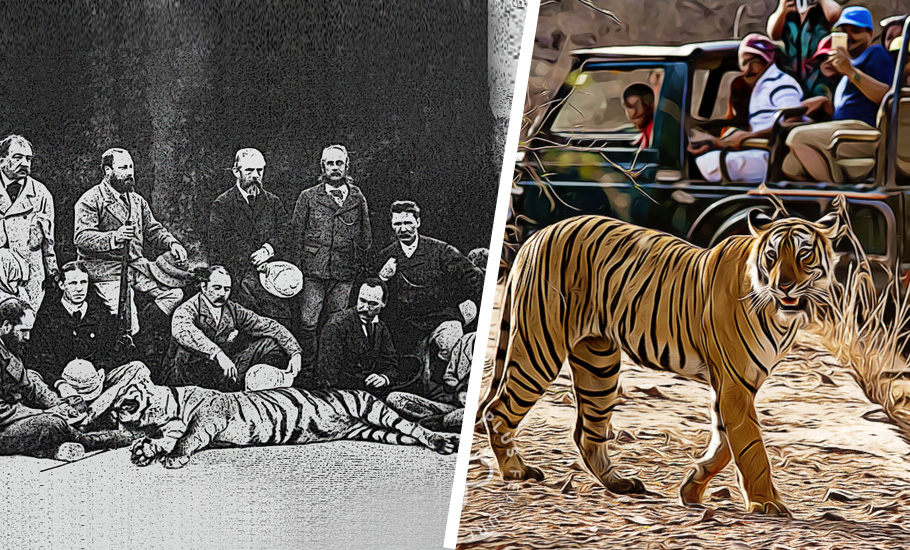
Bullets then, cameras now: There’s no respite for the tiger in India
Yesteryear 'villain' to Instagram icon, the beleaguered cat has seen it all

Is the tiger fated to live on the edge of panic and in perennial desperation? A hundred years ago, it suffered the wrath of multitude of trophy hunters, authorised duly by the British government, and for some years after Independence by the Indian government too, to fetch its shining coat. Today it is being chased all around by armies of camera totting tourists and photographers.
From menacing villain to hapless victim
It’s amazing to see how the pendulum has swung the other way in such a short span of time. Short, when one considers the life cycle of a species. Till a century ago, the poor tiger, still struggling to come out of the bush, could not find a friend to share the tragedy of its life. William Blake’s ode (The Tyger) to its mythical powers and mystique notwithstanding, it remained, by and large, the favourite punching bag of almost everybody.
Also read: Status of Tigers’ report: India has 3,682 tigers; MP retains top spot
Rudyard Kipling, thanks to his all-time bestseller The Jungle Book (and later followed by Walt Disney in two versions of the films with the same title), painted tiger as the blackest of black villains. Suddenly, Kipling’s villain Sher Khan found itself pushed into the hallowed club in which Professor Moriarty, Dracula and Dr Frankesnstein and others were its esteemed members. This trend of tiger-bashing continued for quite some time. So how could Bollywood resist the temptation of jumping into the bandwagon? In his hey days, superstar Amitabh Bachchan fought duels with a tiger in two different films (Mr Natwarlal and Khoon Pasina) – once to save the heroine, and then to prove his muscular prowess.
Nuisance of flashing cameras
Now of course the situation has changed, but maybe not for the better. Though no longer hunted at will, the tiger is nevertheless finding itself more beleaguered and hapless than ever. It’s running from one place to another, not to save its skin but to escape from the army of camera totting tourists and photographers who descend upon his jungles, his paths and his territories for good seven or eight months a year.
There is no escaping this crowd, whose first love is a cover picture in Facebook or an Instagram reel with a tiger. Why, nothing would be better than a selfie with tiger in the background!
Also read: How Jim Corbett typed his books, about man-eating tigers and leopards, with one finger
Don’t believe me? Just have a look at the social media posts dedicated to the tiger. In dozens of pages, hundreds of new photographs of tigers appear every day without fail.
The possibility of a tiger losing, in some degree, its allure in the face of tens of thousands of photos and videos being churned out and celebrated week after week in Facebook, Twitter and Instagram is but one side of the coin.
Booming numbers, shrinking habitat
The other side, which can be quite serious in its repercussions, pertains to too many tigers which India seems to be having at the moment. The last census, made public early this year, pegged the tigers in India to 3,167. A healthy figure, but maybe too healthy for them.
Watch | 50 years of Project Tiger: A Roaring Success
The fact remains that while the tiger numbers have increased impressively, the area of forests which can hold them has remained more or less the same. In fact the quality of forest outside of a national park or sanctuary has degraded at several places in the country. As a tiger is a territorial animal, the less powerful gets pushed outside the forest by a more powerful tiger, where it often comes face to face with humans. When this happens, the consequences are often disastrous for humans.
It might be pertinent to remember these home truths when next time you enter a forest and, coming across a tiger ambling ahead of your Gypsy, urge the driver to speed up so as to get that most sought after “head-on” shot of the tiger. Why? Because that photos will get more likes and love emojis on your Facebook posts!
Also read: Tiger 24: India’s most controversial maneater debuts on Prime Video India

